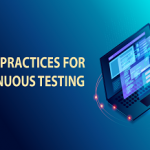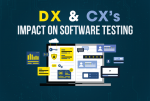A lack of planning or foresight can doom Digital Transformation (DX). To provide the best customer experience (CX) possible, check out this strategic guide to effectively plan and implement your DX.
Many organizations have sped up their processes in the name of Digital Transformation (DX). Part of these changes were business necessities brought about by an unprecedented health issue. The global pandemic of COVID-19 has had more effect in driving DX projects than any other business challenge in the past few decades. Having said that, the benefits to performing a DX project(s) go beyond the present concerns. Ultimately every DX project aims to improve the Customer Experience (CX).
Those customers may be external or internal but the end goal is the same: At the end of the day, CX needs to improve––or at the minimum have a net-zero change. Any DX project that results in a lower CX is money wasted. CX drives customer retention, word-of-mouth, and has a big hand in determining if your customer base will grow, stagnate, or shrink.
CX relates to every interaction our customers have with us: The UI of our application; the help documentation we provide; our responses to phone calls and email; the alerts and notifications our application provides. We invest in new, lighting-fast technology to deliver speed and quality to our customers; we invest in CRM software to get that much closer to our customers and better understand their needs.
Nearly half of all companies say improving customer experience and customer satisfaction were the leading influences to start a Digital Transformation.
Having said all that, a lack of planning or foresight can doom Digital Transformation projects. At the current time, the COVID vaccine rollout may spell a partial return to the world we once knew; but, we will also be embarking on a new normal, one where customers, employees, and colleagues have learned a few new strategies out of necessity that will now be differentiators going forward. In short, we cannot and will not return to yesterday; instead, we will move forward. Digital Transformation is going to be a primary driver in that move forward. And while you cannot stop this overarching transition into an increasingly-digital world, there are many steps you can take to ensure that your organization emerges on the other side successfully.
The 4 Components of Digital Transformation
The Harvard Business Review’s article “Digital Transformation Comes Down to Talent in 4 Key Areas”, showcases several areas necessary for successful Digital Transformation projects. These areas are technology, data, business processes, and the ability for organizations to implement change. To be clear, lacking in any one of these areas could spell defeat for our Digital Transformation efforts. In the end, each one of these may seem to be a technical challenge, but ultimately all 4 are people challenges: Creating a team to spearhead the initiatives, do the work, get buy-in from all stakeholders, and then make these changes a literal part of the organization’s DNA is critical. Here are some guiding questions and ideas that can help you form a rough idea of where your organization is currently at in these areas, allowing you to begin to develop some actionable next steps for your Digital Transformation.
Technologies
What kind of technologies will our Digital Transformation require? We might need to consider cloud implementation or to scale our infrastructure. Our applications might need to be modified, both customer facing and internally. Do we have people on our team(s) that can help us implement these changes? If not, we will need to recruit those people in the future and we will need an appropriate budget to hire them. The tools we want to utilize may be available off the shelf or we will need to develop them ourselves. How much of a mix of the 2 will we need? Asking yourself these questions early on allows you to not only have a better idea of where you’re currently at technologically-speaking, but also identify areas that you’ll need to improve and address when strategizing your Digital Transformation.

Data
How will we utilize and secure data? It is critical that we take advantage of the data that we receive. Having analytics is a positive––but only if they can be used effectively to help us make better business decisions! We need to understand the infrastructure necessary to gather, store, and act on the data we create and receive. We will need to understand where our data will interact with other organizations and what tools and processes they will need to be available in. It is also critical that the data we gather and/or create is secure and that we have the proper tools and processes in place to keep it secure.
Processes
What processes will we need to implement or change? One big area would be to prevent or minimize knowledge silos. This is important as we don’t want blind spots in the processes and workflows we develop. More to the point, these processes are meaningless if our customers are the beneficiaries (and genuinely experience the benefits) of these changes.
Change Capability
How can we determine the level of change capability in our organizations? This is less about technology specifically and more about how we deal with people. If we make all of the technological changes but then do not follow up with proper leadership, mentoring, support, and effective application of learning for all participants, our efforts will be slowed at best or potentially stunted entirely. In short, remember that every Digital Transformation is at its core dealing with people and people interactions.
As I emphasized before, lacking in any one of these areas could spell defeat for our Digital Transformation efforts. Thus, it’s extremely important that we understand the exact caliber of what we’re getting ourselves into when it comes to a Digital Transformation. It doesn’t matter if you invest in the top-tier of the #1 CRM tool if your team doesn’t have the capability to embrace this technology change. Likewise, if you’re looking to speed up process efficiency, nothing will come of it if your technological stack isn’t able to support it. Digital Transformations are projects of a large scale that intertwine many separate aspects of the business; so, when the time comes for you to strategize your company’s DX, you need to take into account all of the interdependencies of these aspects.
7 Pillars of an Effective DX Strategy
Over the years, I have witnessed both successful and unsuccessful Digital Transformations. There have been incremental changes, such as the way that Automation was handled, or much larger changes, such as re-architecting our software model to migrate from on-premise applications to existing completely in the cloud. Ultimately, the projects that were successful benefitted from having a strategy and a game plan to help meet the objectives set.
Nancy White has written about “7 Tenets of a Successful Digital Transformation Strategy” and several of her recommendations align with my own experiences.
Align on the Why
What is the purpose for the change? I’ve been actively involved numerous times in implementation of Automation where it either did not exist before or where it was lacking. Ultimately, the purpose was easy to focus on. Many of the manual steps were repetitive and automating them freed up my hands and eyes to focus on more important and interesting issues in testing. We of course realized that it was impossible to automate everything and that was not our goal. It was to implement tests that would be the most helpful and recapture as much time as possible for us. Understanding that made the project targeted and more easily attainable.
Prepare for Culture Change
The key here is to realize that people are at the heart of every organization and the goal of any transformation is to help those people be more effective. I’ve worked on systems that at one time resided in company’s data centers and installing/upgrading these systems was tedious and often left to individuals to complete on their own––which many times led to those updates never being applied. By moving to a SaaS model, we were able to make it easier to monitor systems that needed to be updated, and if organizations hadn’t, we could inquire as to why and if they needed help or if there were other issues. To make that change, though, required that we considered what the people who were using the systems needed and how we could most effectively meet those needs.

Start Small, But Strategic
As many of the Digital Transformation initiatives will dovetail into each other, there will always be an order as to what gets accomplished and when. Trying to tackle everything at once will be both demoralizing and likely ineffective, as there will be too much to do and the will to do it will taper off. By putting things in an order and determining which changes will be the most beneficial, we can build momentum to get to the next step. As I was part of a transformation related to moving from delivering executables for customers to install to cloud implementations, our CI/CD pipeline and processes was the first place we focused our attention. By making it possible to test and assemble the components necessary for a straightforward deployment process, we were able to reduce both the time and steps necessary to deliver releases and deploy them on systems.
Map Out Technology
Using the CI/CD example, we initially started out with a monolithic system that, over time, developed into one that leveraged containerization, parallel processes, and the ability to build and deploy multiple components with each step. While it may not be possible to have every piece of the puzzle in place at the first step, it’s important to consider what future needs will be and to plan accordingly. It is frustrating to start on a transformation project, get halfway through, and realize that the needs are going to be larger than what was planned for, or that the solution chosen is not adequate for the situation or will not scale appropriately.
In the case of Test Automation, there may be a need to get up to speed quickly but a lack of present knowledge with existing Test Automation frameworks. To that end, tools like LogiGear’s Low-Code Test Automation tool TestArchitect may help jump start that process and get more people up and actively participating than other tools that have steep learning curves or require a thorough knowledge of coding to operate.
Seek Out Partners & Expertise
Sometimes, companies will struggle with how to accomplish certain tasks or will need help in implementing certain strategies. Knowing when and where to ask for help can make or break an initiative. Organizations like the LogiGear Group have the expertise, experience, and technical know-how that can vastly accelerate your DX projects.

Gather Feedback & Refine
Odds are, if this is your first time approaching a Digital Transformation project, there will be some bumps in the road. My experience has shown that even multi-year projects with many transformation steps have some successful outcomes and some areas that struggle. The key here is to get feedback from your customers (external and internal) and see how we are doing. It’s rare that the project gets it all right the first time. There will always be room for improvement and discoveries of how to make the process better. Solicit feedback, see where the sticking points are, and then work to remedy those areas. Expect this process to be ongoing––Rome wasn’t built in a day.
Scale & Transform
Once an area of concern has gone through the Digital Transformation process, determine if what you have done is reusable for the next step or if it makes sense to do a parallel transformation. You may have started with part of your customer base moving to the cloud. Once you have done that, determine the next step to get to 50%, 75%, or 100%. If you have optimized the CI/CD pipeline, see if you have other applications that can benefit from a similar process. In short, once the rock starts rolling, keep it rolling in a controlled and directed manner.
Summary: Don’t Be Tardy to the DX Party!
Digital Transformation can seem daunting, but it is not impossible nor does it have to be doomed to failure. By getting a clear picture of what the goals are and who can accomplish the tasks necessary, as well as making a game plan to achieve our goals, we can count ourselves in the successful category. It will take time, talent and energy but it can be done. It’s important to keep in mind that there is no “one-size-fits-all” DX strategy; like your organization and business needs, each Digital Transformation is unique and should be custom-tailored to ensure you’re making the most of your tech investment.
Strategizing your DX is easier said than done. That’s why experts like the LogiGear Group can help you jumpstart your DX strategy with an initial consultation. Get in contact with our team of experts today, and we can work with your organization’s current state to establish a roadmap that will get you to your future state, all while driving customer value, increasing quality, and streamlining your processes.
So, don’t be tardy to the Digital Transformation party! You can’t digitally transform overnight (unfortunately), but the longer you wait to start, the longer it will take to realize the benefits.


















